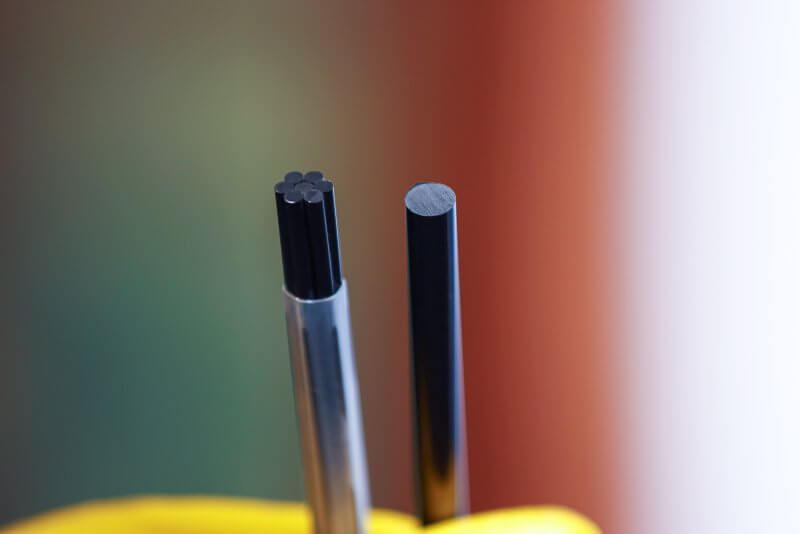Standardization powers transmission and distribution industry
In 2024, the International Electrotechnical Commission (IEC) published a new technical specification for conductor cores. Antti Hassinen, part of the committee that produced IEC TS 62818-1 and Director of Product Management at Exel Composites, explains how composite conductor core standardization, built on cross-industry collaboration, helps align shared interests and accelerate the modernization of transmission infrastructure.
Advanced conductors offer great leaps forward in transmission capacity and efficiency. High temperature, low sag (HTLS) conductors with carbon fiber cores offer double the transmission capacity, lower transmission losses, and major sag reduction compared against traditional aluminum conductor steel reinforced (ACSR) conductors and All Aluminum Alloy Conductor (AAAC) conductors.
Carbon fiber cores achieve this because of their much lower coefficient of thermal expansion and density, allowing more conductive aluminum to be stranded around the core. Heat negligibly affects carbon fiber, allowing HTLS conductors to operate at 180°C, while the expansion of steel leads to sagging limitations in ACSR conductors in the 85-100°C range.
IEC TS 62818-1 is a new proposal for composite conductor core standardization, following ASTM B987, which only covers single-wire carbon fiber cores with glass surfaces, i.e. hybrid cores. The IEC’s specification provides quality guidelines and defines suitable testing methods to enable transmission system operators (TSO) to compare the range of commercially available composites conductor cores.
Standardization as a de-risking tool
But introducing new technologies can also bring an element of uncertainty. In infrastructure cases particularly, worthwhile upgrades may require millions, even billions of dollars of investment. Infrastructure owners like TSOs must therefore have confidence that the solutions they choose will endure the test of time.
Incumbent ACSR conductor cores are ageing and limited: around 40 per cent of Europe’s grids are over 40 years old and more than 50 per cent in North America exceed 30 years of age. As electrical grid operators wrestle with the surging power demands of electrification of transport, industrial activity, heating, and the integration of renewable energy sources to the grid, this new era of transmission infrastructure has already begun.
Elia, the Belgian TSO, for example, has been reconductoring its grid with advanced conductors since 2009 and expects to replace conductors across the majority of the country’s 380 kV transmission lines by 2034.
IEC TS 62818-1 plays an important part in providing peace of mind to the TSOs making this modernization effort. This is the first time an international specification has provided a unified testing and qualification framework for composite conductor cores, independent of design, material, or surface treatment.
For example, I used my experience in developing manufacturing line concepts, quality standards, reporting, traceability, and testing methods to contribute to the specification’s guidelines on IEC TS 62818-1 testing. These contributions ensure product compliance across decades of service life.
For instance, the Arrhenius method evaluates long-term thermal stability, which extrapolates material performance over time by correlating temperature-dependent degradation with mechanical properties. In this context, we can monitor the relationship between elevated temperature and axial tensile strength as a function of time to predict compliance throughout the product’s operational lifespan.
For manufacturers along the value chain, the standardized language, acceptance criteria, and testing methodology provides a clear way to demonstrate their products’ performance without redundant or conflicting national standards. For TSOs, homogenizing standards eliminates the uncertainty of comparing different solutions that are evaluated on different bases.
Assembling stakeholders to move forward together
The feedback around the time TS 62818-1 was developed was thoroughly positive; discussions with TSOs, grid companies, and conductor manufacturers in the years leading up to its publication all pointed towards an industry-wide desire for easier evaluation and access to this technology. In 2024, the then-secretary of the U.S Department of Energy said grid-enhancing technologies (GETs) like this were “the lowest-hanging fruit for adding capacity to the grid at the least cost”.
In fact, it was this combination of partners that enabled the creation of TS 62818-1 in the first place. By recruiting perspectives from industry experts at each stage of the value chain, the IEC committee had a clear view of what the market needed to be able to rely on the technical specification for decades to come. Composites and conductor manufacturers, TSOs, and utility companies all shared expertise in materials, mechanical integration, operational and reliability needs, and risk management.
Exel Composites, for example, worked to achieve the International Automotive Task Force (IATF) 16949 quality management standard for several years, so it was able to share the manufacturing and production insights learned from that process. In fact, our team was applying the guidelines and testing standards described in IEC TS 62818-1 for years before it was published.
Exel’s main contribution was a deep knowledge of composite manufacturing using pultrusion. Pultrusion is a continuous manufacturing process ideally suited to making long lengths of two-dimensional composite material, just like the carbon fiber rods used in conductor cores. Exel has used pultrusion for decades and brought its technical understanding of how to engineer desired properties and demonstrate them through materials characterization, as well as its production and testing facilities.
However, Exel has also positioned itself as an industry partner for the entire transmission industry, not just the conductor manufacturers who are its direct customers. Through organizations like the IEC and the International Council on Large Electric Systems (CIGRE), it spreads its technical knowledge by publishing research and giving talks at conferences.
I myself presented data on the effect of broken wires within multi-strand carbon fiber cores at the CIGRE conference in Trondheim, Norway, in May 2025. I look forward to comparing the flexibility and robustness of single- and multi-strand carbon fiber cores at the CIGRE International Symposium in Montreal, Canada, in September this year.
By actively participating in shared interest groups and associations in this way, companies with visions for the future can connect partners together to work for the betterment of the industry. IEC TS 62818-1 is a great example. It will be developed further into a ratified IEC industry standard, giving mandatory requirements for thermal elongation tolerances and other material properties, standardized testing procedures, and long-term reliability.
To learn more about Exel’s composite conductor core technology, download our free whitepaper on the topic here!

